We were blessed with a beautiful Saturday. Crystal blue skies and gentle winds met with cool temperatures to give us a perfect day for the Lejeune Cove Mardi Gras Run.
A Courir by any Other Name
Mardi Gras loosely defined is celebrated in many parts of the country. From Washington D.C. to Galveston, Texas one can find a Mardi Gras celebration. But the Courir de Mardi Gras can only be found in South Louisiana. It’s the only true Mardi Gras. The tradition dates back over four hundred years.
The Courir de Mardi Gras is a day of social upheaval. It’s a day when riders of horses, and riders in a large, truck pulled wagon travel the country side to entertain home owners and collect either money or ingredients for a community gumbo.
The participants are called Mardi Gras (the word is its own plural), and they are dressed in brightly colored costumes with fringe. The costumes are a patchwork of many small pieces of heavily patterned fabrics. A tall, pointed hat called a capuchon (cap-PUH-shon), wrapped in a similar patchwork fabric adorned with bells and fringe, is worn on their heads. A grotesquely decorated mask made of fine screen covers the Mardi Gras’ face.
It’s a curious sight these Mardi Gras. It can certainly be intimidating, and somewhat frightening to those who do not know the history and tradition. And that is what we are talking about here, history and tradition.
The Famous Mr. Ed
One of the best known stops on this run is at the home of Mr. Ed Lejeune and his gracious wife Kathy. Ed was good enough to invite my family and I to his house this year, and what a time we had. It is quite a sight to see what Ed and Kathy put on for the Courir de Mardi Gras. With some help from friends Ed cooks over 300 hamburgers, 30 pounds of Cajun sausage, 30 pounds of boudin, along with king cake, chips and dips, and the like.
A twenty-first century device is being used to play nineteenth century music while we celebrate a seventeenth century ritual.
We make our way down a long, gravel road. Ed’s house is at the end of that gravel road known as Back Acres Lane. Ed lives off of the black top, and well into the country.
He has a modest, well-kept house with a lot of land. There is a barn with a corral where the festivities are being held. We park our cars and trucks neatly in rows in a mown field. Before we can get out of the truck we see Harlan and Loretta Kebodeaux along with their two girls Leslie and Janet. We haven’t seen the Kebodeaux’s in a good while so I catch up with Harlan, and my wife Paulette does the same with Loretta. It’s always nice to go somewhere and see friends you know well. That’s part of the beauty of small town and country living.
As we all walk towards the barn we can smell the food cooking, and it smells great. Some traditional Cajun music is playing from a laptop computer through a small speaker setup. It’s right then that you realize that the past and the present walk together hand in hand. A twenty-first century device is being used to play nineteenth century music while we celebrate a seventeenth century ritual.
I met Ed and thanked him for inviting us. Humble as always he said that he was glad that we could make it there. I met Ed’s brother Thomas who insisted that I not tell anyone that he is Ed’s brother. He said he didn’t want that kind of thing getting out. I agreed with him. Thomas is a character indeed. He is what we call canaille (KAHN-nigh). It means mischievous. I can spot canaille a mile away, and Thomas is canaille.
I look over at the men working the grills and see a former principal of a local elementary school Jesse Joubert. He and the other guys are doing a fine job cooking and “making smoke” like we say.
A steady stream of people arrive at Ed’s and slowly a few is turning into a bunch, and then a crowd. I asked Ed how many people are going to show up. He said, “I’m not sure. When we first started this fourteen years ago we were only about ten people plus the Mardi Gras. Now I guess a good bit over a hundred plus the Mardi Gras.”
The Show of all Shows
After a couple of hours of tongue wagging and visiting the Courir makes it’s way down Back Acres Lane and the real fun starts. The horse riders tie up their steeds, and the ones on the trailer disembark. Almost immediately they kneel and chant in unison that ancient French poem:
LA CHANSON DE MARDI GRAS
Oh Mardi Gras, ou deviens tu,
Tout alentours du fond d’hiver?
Oh Mardi Gras, ou deviens tu,
Tout alentours du fond d’hiver?
Je viens de l’Angleterre,
Oh mon chere, oh mon chere.
Je viens de l’Angleterre,
Tout alentours du fond d’hiver.
Oh Mardi Gras, quoi portes-tu,
Tout alentours du fond d’hiver?
Oh Mardi Gras, quoi portes-tu,
Tout alentours du fond d’hiver?
Je porte une bouteille,
Oh mon chere, oh mon chere.
Je porte une bouteille,
Tout alentours du fond d’hiver.
Oui, la bouteille est bu,
Tout alentours du fond d’hiver.
Oui, la bouteille est bu,
Tout alentours du fond d’hiver.
Il reste que le plein verre,
Oh mon chere, oh mon chere.
Il reste que le plein verre,
Tout alentours du fond d’hiver.
Oui, le plein verre est bu,
Tout alentours du fond d’hiver.
Oui, le plein verre est bu,
Tout alentours du fond d’hiver.
Il reste que la rincure,
Oh mon chere, oh mon chere.
Il reste que la rincure,
Tout alentours du fond d’hiver.
Oui, la rincure on la boit pas,
Tout alentours du fond d’hiver.
Oui, la rincure on la boit pas,
Tout alentours du fond d’hiver.
Bonjour le maitre et la maitresse,
Et tout le monde du logis,
On vous demande bien peu des choses,
On vous demande la fille annee.
On lui ferra chauffer ses pieds,
On lui ferra faire une bonne chere!
They do not speak beyond that. Just the all too familiar “whoop!” They ask for money, grab people’s legs, carry babies around, and dance with visitors as a live French band has taken the place of the computer.
They climb in trees, walk the rails of corral, and of course, are relentless in harassing the capitaines. They grab the burlap whips, take their hats, tackle them and roll around in the dust and grass.
It’s all for show of course, but it is also symbolic of a people checking those who seek to control them. Mardi Gras is its own social construct. It seeks to level the playing field between the haves and the have nots. It means to show that society is sometimes as grotesque as the masks the Mardi Gras wear. There is symbolism everywhere and it is striking.
After a little while Ed releases three chickens one by one for the Mardi Gras to chase. No symbolism here, just a chance to laugh at some couillions chasing a chicken around. They dive in the dirt, bounce off of barn walls, jump fences, and wade through tall grass for the poor poultry. Each live bird being the prize of the one who catches it. In years past that chicken would have found himself in a gumbo pot. Today however, the chickens are purchased before hand, and the chasing is simply fun to watch.
The Mardi Gras take some time to take off their masks, eat some good food, and visit with everyone there. Smiles are everywhere as stories of the day, and days past, fill the air.
Young, old, and every age in between are here, and for a brief moment the young listen to the old attentively. They listen as the elders tell tales of how it used to be. And how it used to be is amazingly similar to how it is today. Thank you Ed and Kathy, and all involved in keeping this most Cajun tradition alive and well.
The horn blows on the truck and it’s time for the Mardi Gras to go. They mount their horses, and climb on the trailer. One more house to stop at and then a break until the dance tonight.
Courir into the Night
As night falls we find our way under the large pavilion at La Pay e Bas camp ground. The Mardi Gras dance is traditionally held here and this year was no different. The night is much the same as the day. The Mardi Gras dance in a procession two abreast as they make their way to the band. They kneel, they chant, the whoop, they holler, they collect money, and they leave. Well, the capitaines have to persuade some of them to leave.
I noticed a wooden cross mounted in the rafters along with an American flag. It struck me then that here is a deeply French Catholic tradition that is firmly seated in the South of America. Again I am humbled and thankful to be Cajun.
Allons Cajuns!!
Allons Mardi Gras!!
Stay hungry.


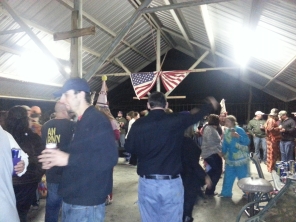
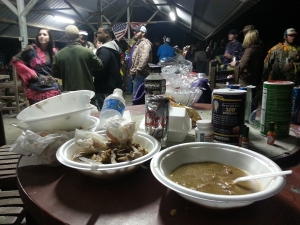

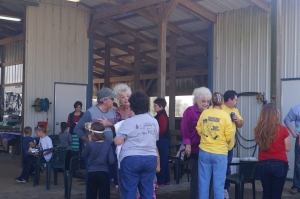

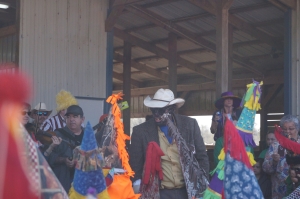
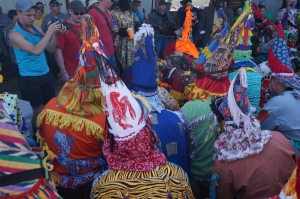
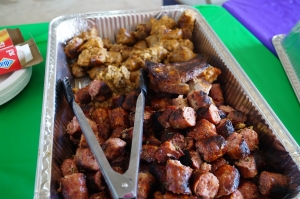
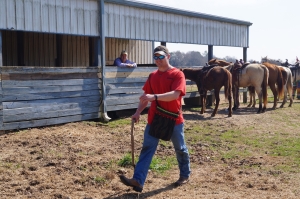
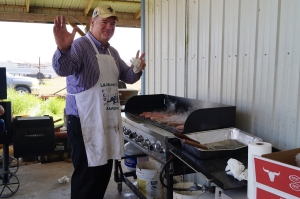
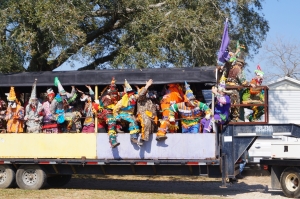
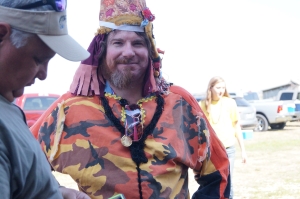
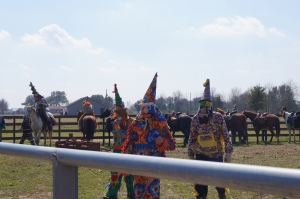
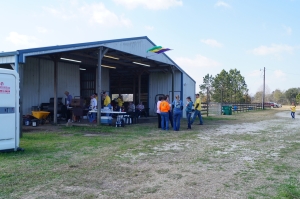

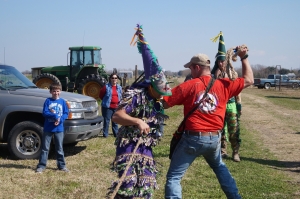
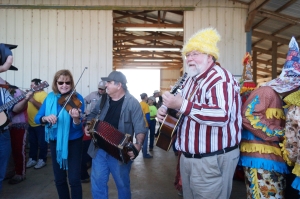
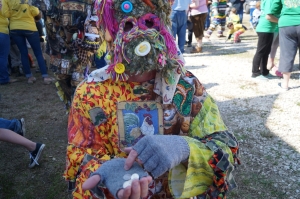
Thanks for posting the Mardi Gras!
LikeLike
They do something similar in Mamou lol. Old traditions are hard to find nowadays
LikeLike